Soyuz MS-04 flies reduced crew to ISS (original) (raw)
Soyuz MS-04 delivers reduced crew to ISS
In the first manned launch of 2017, the Soyuz MS-04 spacecraft delivered two members of Expedition 51 and 52 to the International Space Station, ISS. Roskosmos made a decision to reduce the Russian crew aboard the ISS beginning in 2017 to save funds. After a technical delay, a liftoff of Soyuz MS-04 was re-scheduled for April 20, 2017. The spacecraft is expected to remain docked at ISS until Sept. 3, 2017.
Previous Soyuz mission: Soyuz MS-03
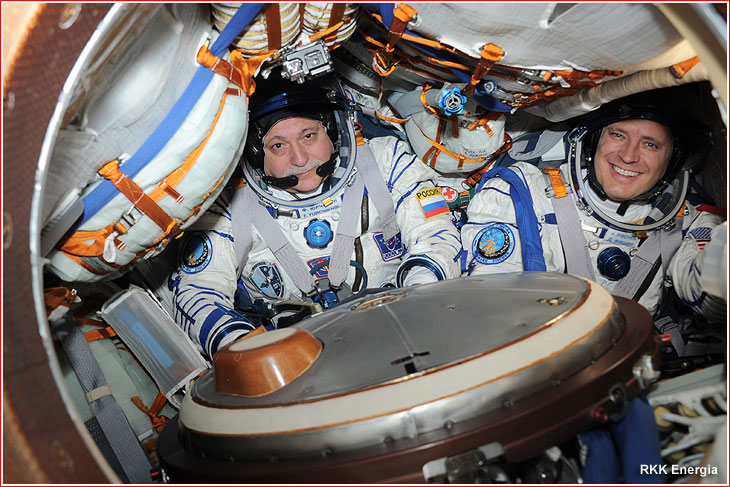
Crew of Soyuz MS-04: Roskosmos cosmonaut Fyodor Yurchikhin in the center seat and NASA astronaut Jack Fischer in the left seat try out their spacecraft on April 6, 2017. The right-hand seat was occupied by a cargo container during the mission.
From the publisher: Pace of our development depends primarily on the level of support from our readers!
Soyuz MS-04 mission at a glance:
| Spacecraft designation | Soyuz MS-04 (11F732 No. 735, ISS mission 50S, NORAD ID: 42682, 2017-020A) |
|---|---|
| Launch vehicle | Soyuz-FG |
| Launch site | Baikonur, Site 1, Pad 5 |
| Crew | Fyodor Yurchikhin (Roskosmos), Jack Fischer (NASA) (ISS Expedition 51/52); Peggy Whitson (NASA) (down only); arrived on Soyuz MS-03 |
| Launch date and time | 2017 April 20, 10:13:43.171 Moscow Time (3:13 a.m. EDT) |
| Docking at ISS date and time | 2017 April 20, 16:23 Moscow Time (9:23 a.m. EDT) |
| Docking location | MIM2/Poisk module of the Russian segment |
| Landing | 2017 Sept. 3 |
| Mission duration | 136 days |
Ship replacement
As of 2014, the Soyuz MS-04 mission was planned for March 30, 2017, but the launch was later advanced to March 27, 2017, during the adjustment of the overall ISS flight manifest.
On Jan. 16, 2017, Roskosmos announced that the vehicle with a production number 735 would be used for the Soyuz MS-04 mission, instead of previous plans to fly Vehicle No. 734. Roskosmos said that the swap had not been due to "technical reasons," but in reality, it was caused by a leakage discovered in the thermal control system, SOTR, of Vehicle No. 734. As a result, the launch of the Soyuz MS-04 mission had to be postponed from March 27 until April 20, 2017, at the earliest, depending on the readiness of Vehicle No. 735. The subsequent mission of the Soyuz MS-05 spacecraft also had to be delayed from May 29 until around July 28, 2017.
Preparations for launch
On March 17, 2017, RKK Energia, the Soyuz developer, announced that its team had been preparing Soyuz MS-04 for vacuum testing at the 17T523 facility in Baikonur. On March 23, the company said that the vacuum testing had been successfully completed. The processing of Soyuz MS-04 continued with the testing of the solar panels and batteries onboard the spacecraft. The operation included opening of the solar panels and their exposure to the light from a special array of lamps with the simultaneous monitoring of the electric current flow through the vehicle's cable system, RKK Energia said on March 29.
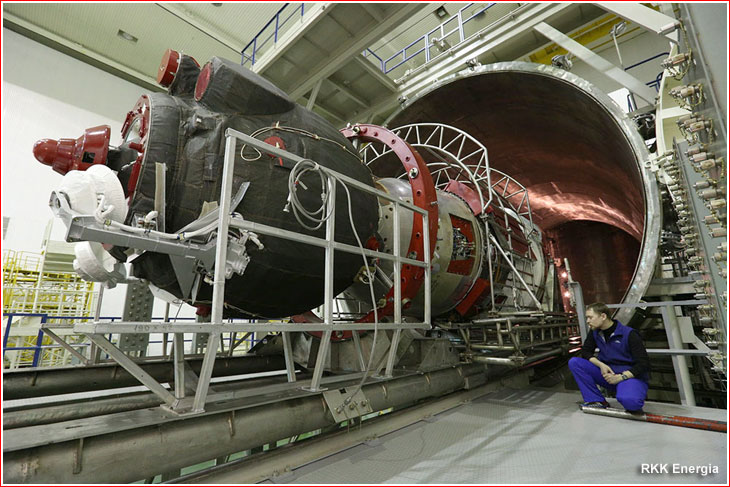
Soyuz MS-04 is being prepared for vacuum testing.
The primary and backup crews, which had been training to fly aboard Soyuz MS-04, arrived to Baikonur on April 5, 2017, and the next day, inside the processing building at Site 254, cosmonauts and astronauts sat in the descent module of the vehicle, familiarizing themselves with its flight configuration. According to RKK Energia, the crew tested radio communications system, a laser range finder, checked onboard documentation and went over its flight program and a cargo list. The rehearsal of manual control and upcoming ballistic operations, as well as a the review of mission payloads was also planned, the company said.
On the same day, technical managers of the project met to approve the irreversible operations, including loading of the spacecraft with propellant and pressurized gases. After the completion of the fueling operations, Soyuz MS-04 returned to its processing building on April 8, 2017.
On April 10, an RKK Energia team completed integration of Soyuz MS-04 with the adapter which will connect the spacecraft to its launch vehicle. On April 12, experts had conducted traditional final inspection of the spacecraft, before it was lowered into horizontal position and rolled inside its protective payload fairing of the Soyuz FG launch vehicle.
On April 14, the payload section containing the Soyuz MS-04 spacecraft was transferred from the spacecraft processing building at Site 254 to the launch vehicle assembly building at Site 112 for integration with the Soyuz-FG rocket, which was successfully completed on April 15. On the same day, mission management gave green light to the rollout of the Soyuz-FG rocket with the Soyuz MS-04 spacecraft onto the launch pad. On the morning of April 17, the vehicle left the assembly building and arrived at Site-1 where it was installed in vertical position.
Soyuz MS-04 launches fresh crew to ISS
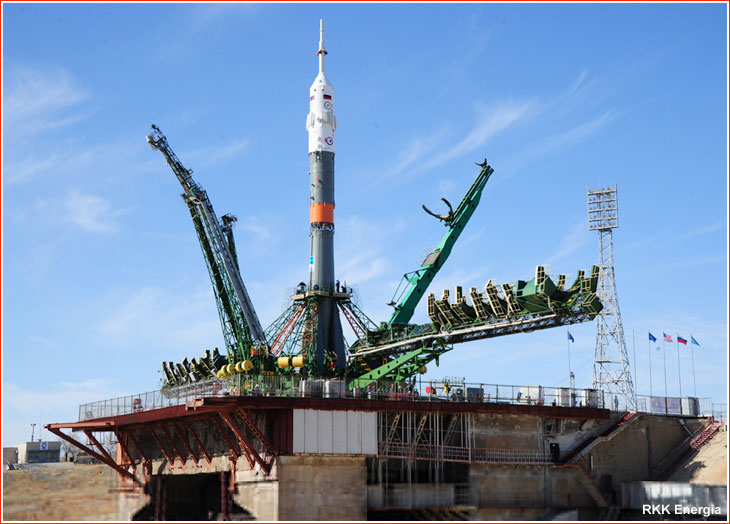
A Soyuz-FG rocket carrying the Soyuz MS-04 spacecraft lifted off as scheduled on April 20, at 10:13:43.171 Moscow Time from Pad No. 5 at Site 1 in Baikonur Cosmodrome.
Propelled by the simultaneous thrust of the four engines of the first stage and the single engine of the second stage, the rocket headed east to align its ascent trajectory with an orbital plane inclined 51.67 degrees toward the Equator. Slightly less than two minutes into the flight, the ship's emergency escape system was jettisoned, immediately followed by the separation of the four boosters of the first stage. Almost exactly 40 seconds after the separation of the first stage, the payload fairing protecting the spacecraft in the dense atmosphere split into two halves and fell away.
The second (core) stage of the booster continued firing for less than five minutes into the flight. Moments before the second stage completed its firing 4.7 minutes into the flight, the four-chamber engine of the third stage ignited, firing through a lattice structure connecting the two boosters. Moments after the separation of the core booster, the tail section of the third stage split into three segments and fell away.
The third stage continued firing until the command to cut off its engines at 8.7 minutes into the flight. Soyuz MS-04 separated from the third stage at 10:22:32.26 Moscow Time (3:22 a.m. EDT) on April 20.
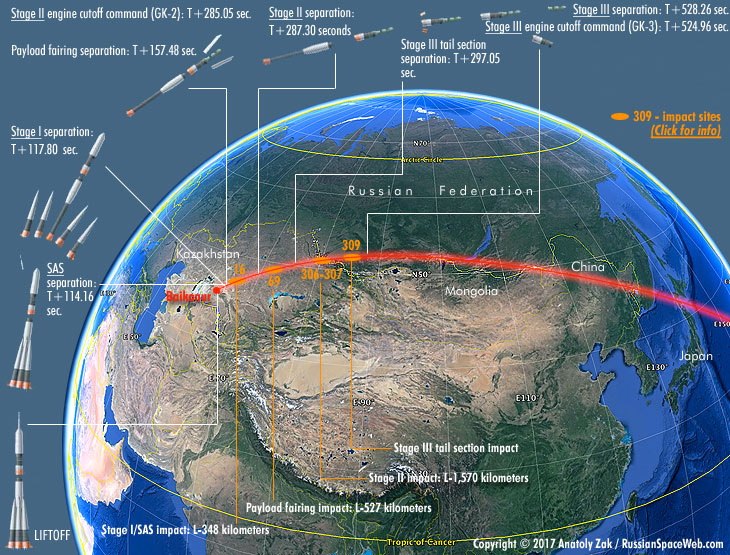
Soyuz MS-04 to reach the station in six hours
According to the mission control in Korolev, Soyuz MS-04 entered a nearly planned orbit:
| Parameter | Planned orbit | Actual orbit |
|---|---|---|
| Orbital period | 88.64 minutes (+/-0.367) | 88.77 minutes |
| Inclination | 51.67 degrees (+/-0.058) | 51.64 degrees |
| Perigee (lowest point) | 200 kilometers (+7/-22) | 199.9 kilometers |
| Apogee (highest point) | 242 kilometers (+/-42) | 257.4 kilometers |
Without any additional maneuvers, the spacecraft was guaranteed to remain in its initial orbit for around 20 revolutions around the Earth during the next 30 hours, before reentering the Earth's atmosphere due to air friction.
Upon reaching its planned orbit, Soyuz MS-04 was expected to be approximately 9.3 degrees away and below the ISS, which at the time was circling the planet in the 401.8 by 426.71-kilometer orbit with an inclination 51.66 degrees toward the Equator.
The mission followed a six-hour rendezvous profile with the station. According to the Russian mission control in Korolev, the Soyuz was scheduled to perform one orbital maneuver during its 1st orbit and three more during the 2nd orbit of the flight, which would bring the spacecraft into the vicinity of the station, according to the following planned timeline:
| Orbit No. | Time, MSK | Firing duration | delta V | Orbital period | Inclination | Resulting perigee | Resulting apogee |
|---|---|---|---|---|---|---|---|
| 1 | 10:55:59 | 54.2 seconds | 21.61 m/s | 89.38 minutes | 51.67 degrees | 222.75 kilometers | 273.88 kilometers |
| 2 | 11:33:14 | 59.4 seconds | 23.93 m/s | 90.21 minutes | 51.67 degrees | 273.03 kilometers | 308.05 kilometers |
| 2 | 12:17:15 | 18.2 seconds | 7.00 m/s | 90.46 minutes | 51.67 degrees | 297.17 kilometers | 314.86 kilometers |
| 2 | 12:47:25 | 18.2 seconds | 7.00 m/s | 90.70 minutes | 51.67 degrees | 301.70 kilometers | 333.13 kilometers |
Following its orbit corrections, Soyuz MS-04 was scheduled to begin an autonomous rendezvous with the ISS around 14:12:19 Moscow Time on April 20, 2017, aiming to lock sensors of its Kurs-NA rendezvous system onto the station during the 5th orbit of the mission.
The final maneuvers, including a flyaround of the ISS, a short station-keeping period and berthing were scheduled to commence at 15:57:38 Moscow Time on November 20.
The docking of the Soyuz MS-04 spacecraft and the ISS was scheduled at 16:23 Moscow Time but it actually took place around five minutes earlier at 16:18 Moscow Time (9:18 a.m. EDT).
The spacecraft berthed at the zenith (sky-facing) port of the MIM2/Poisk module, a part of the Russian segment of the ISS.
The opening of the hatches between the transport ship and the station was scheduled at 18:05 Moscow Time (11:05 a.m. EDT) but had to be delayed for 20 minutes due to a pressurization issue.
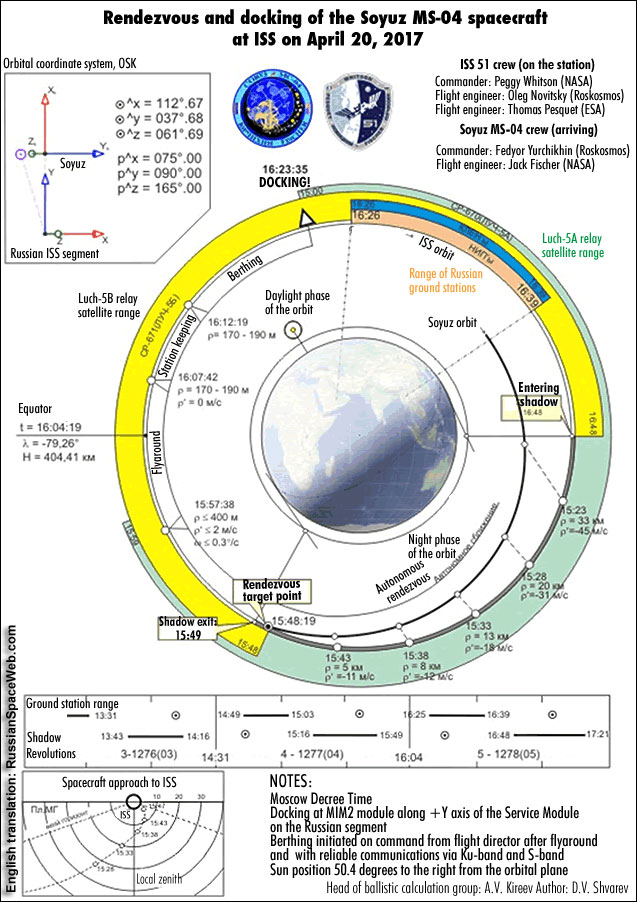
Soyuz MS-04 returns to Earth
Completing their 4.5-month mission, Russian cosmonaut Fyodor Yurchikhin along with NASA astronauts Jack Fischer and Peggy Whitson boarded the Soyuz MS-04 spacecraft and closed hatches to the International Space Station, ISS, around 21:40 Moscow Time on September 2, 2017, (2:40 p.m. EDT) for the ride back to Earth.
The transport vehicle undocked from the ISS on Sept. 3, 2017, at 00:58 Moscow Time (5:58 p.m. EDT on Sept. 2, 2017), as the two spacecraft were flying over Mongolia. Yurchikhin occupied the center seat to pilot the Soyuz, with Whitson to his right and Fischer in the left seat.
NASA predicted excellent weather at the landing site with temperatures around 77F degrees.
After a short autonomous flight, Soyuz MS-04 initiated a 4-minute 39-second deorbiting maneuver at 03:29 Moscow Time on September 3 (8:29 p.m. EDT on September 2), which was completed as planned.
Following the controlled depressurization of the forward habitation module, the spacecraft split into three sections at 8:56 p.m. EDT: the habitation module and instrument module, which both burned up in the Earth's atmosphere, and the descent module carrying the crew.
Following the reentry and the release of a three-tier parachute, the descent module of the Soyuz MS-04 touched down 148 kilometers southeast of town of Dzhezkazgan in Kazakhstan on Sept. 3, 2017, around 04:21:50 Moscow Time (9:21:50 p.m. EDT on Sept. 2, 2017), just 39 minutes after the local sunrise.
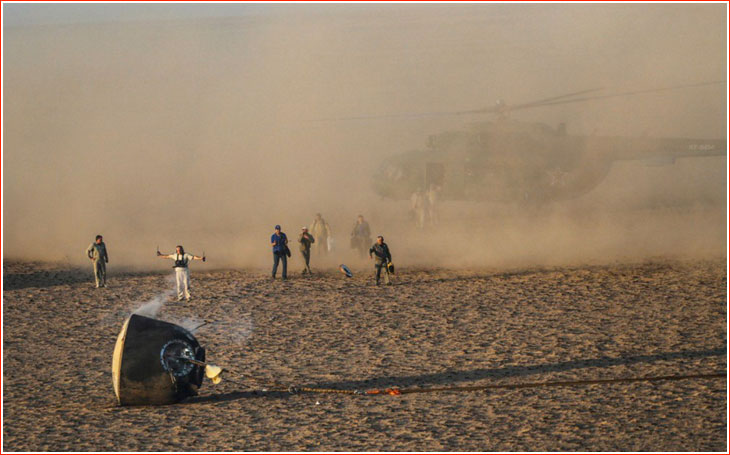
The capsule ended on its side after landing, but rescue personnel quickly extracted all three crew members in seemingly good shape.
According to NASA, as a result of the impact of Hurricane Harvey, the US space agency reviewed return plans to Houston of Whitson, Fischer and the science samples landing in the Soyuz spacecraft. The crew will still participate in standard post-flight medical evaluations, NASA said.
Due to delay with the departure of a NASA Gulfstream jet from Houston, ESA sent its own aircraft from Cologne, Germany, to Kazakhstan to pick up US astronauts and bring them back to Cologne. There, the two astronauts would board the late NASA jet for a second leg of the journey to the US. Yurchikhin will fly a separate Russian jet to Star City.
According to NASA, Whitson is completing a 288-day mission that began in November 2016, spanning 122.2 million miles and 4,623 orbits of Earth – her third long-duration stay on the outpost. At the time of their landing, she will have accrued a total of 665 days in space over the course of her career, more than any American astronaut, placing her eighth on the all-time space endurance list.
Yurchikhin and Fischer, who launched in April, will complete 136 days in space. Yurchikhin will return to Earth with a total of 673 days in space on his five flights, putting him in seventh place on the all-time endurance list.
At the time of undocking, Expedition 53 will begin aboard the station under the command of Randy Bresnik. Along with his crew mates Sergey Ryazanskiy of Roskosmos and Paolo Nespoli of ESA (European Space Agency), the three-person crew will operate the station until the arrival of three new crew members. Mark Vande Hei and Joe Acaba of NASA and Alexander Misurkin of Roskosmos, are scheduled to launch Sept. 12, 2017, from Site 1 in Baikonur Cosmodrome, Kazakhstan.
Soyuz MS-04 crew:
| Primary crew | Backup crew |
|---|---|
| Fyodor Yurchikhin (Roskosmos) | Sergei Ryazansky (Roskosmos) |
| Jack Fischer (NASA) | Randolph Bresnik (NASA) |
| Peggy Whitson (NASA) (return only; flew to ISS on Soyuz MS-03) | - |
Next mission: Soyuz MS-05
This page is maintained by Anatoly Zak; Last update:October 31, 2020
Page editor: Alain Chabot; Last edit: September 4, 2017
All rights reserved
